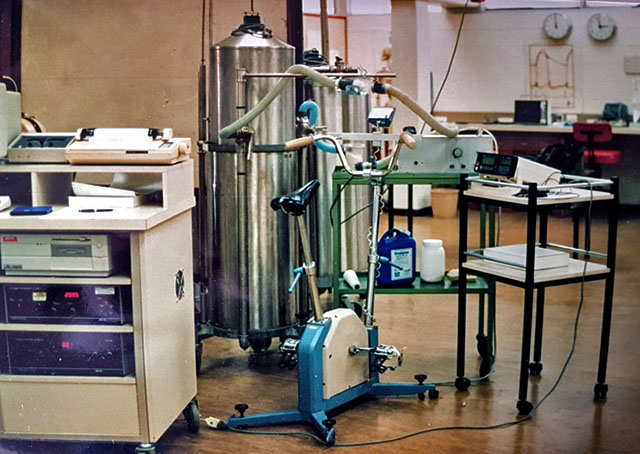The measurement of the body's oxygen consumption (VO2) is commonly used in exercise science. It is the measure of the amount of oxygen that is being consumed by the body to produce energy. It is a useful measure for determining resting metabolic rate (BMR), and during exercise for measuring exercise economy and aerobic capacity (VO2max). A measure of oxygen consumption is also used in the calculation of the respiratory quotient (RQ), which provides information about the use of fats and carbohydrates by the body.
There are many ways to measure or calculate oxygen consumption. Here we describe the method of measuring oxygen consumption by indirect calorimetry, the common method used when testing VO2max in the laboratory. There is also the direct calorimetry method, which is more suited to resting metabolism measurement, and if you don't have the appropriate equipment there are formula and other fitness tests to estimate oxygen consumption.
Indirect calorimetry is a noninvasive and reliable method for assessing energy expenditure and fuel utilization by the body. Indirect calorimetry is determined using calculations based on the volume of air breathed in and the composition of the expired air. The measurement is based on the principle that the volume of oxygen (VO2) and carbon dioxide (VCO2) used by the body is equal to the difference between the volumes of inspired and expired oxygen and carbon dioxide respectively. In other words, if you breathe in a certain amount of oxygen, then breathe out less oxygen, the difference is the amount that the body has used.
 Equipment for measuring VO2 by indirect calorimetry
Equipment for measuring VO2 by indirect calorimetryMeasuring the volume and composition of the expired air
There are several ways the volume of air breathed can be measured. Most commonly, a device (pnuemotach, flow meter or turbine ventilometer) is attached to a mouthpiece to measure the airflow from which the air volume can be calculated.
The expired air may also be collected in Douglas bags or a Tissot tank, and the volume of air measured directly. As the measurement of air volume is affected by the air temperature and atmospheric pressure, these need to be taken into account when doing the calculations. Usually, all volumes are converted to standard temperature and pressure (STPD).
An oxygen and carbon dioxide analyzer are required to measure the concentration (fraction) of oxygen and carbon dioxide in the expired air.
Calculations To Determine Oxygen Consumption (VO2)
Oxygen uptake is calculated from measures of ventilation and the oxygen and carbon dioxide in the expired air. Results are presented as either l/min (liters per minute) or ml/kg/min (mls of oxygen per kilogram of body weight per minute).
VO2 = VIO2 - VEO2
This formula calculates the difference between the amount of oxygen inspired (breathed in) and the amount expired (breathed out). The amount of oxygen inspired (VIO2) or expired (VEO2) is determined by multiplying the volume of air breathed (VI) by the fraction of oxygen in the inspired or expired air ( VI x FIO2 ) or ( VE x FEO2 ). The fraction of O2 in the air we breathe is taken as the standard 0.2095 (20.95%). Therefore,
VO2 = ( VI x 0.2095 ) - ( VE x FEO2 )
Calculations To Determine Carbon Dioxide Production (CO2)
VCO2 = VECO2 - VICO2
This formula calculates the difference between the amount of carbon dioxide expired (breathed out) and the amount inspired (breathed in). The amount of carbon dioxide expired (VECO2) or inspired (VICO2) is determined by multiplying the volume of air breathed (VI) by the fraction of carbon dioxide in the inspired or expired air ( VI x FICO2 ) or ( VE x FECO2 ). The composition of CO2 in the air we breathe is taken as the standard 0.0003 (0.03%). Therefore,
VCO2 = ( VE x FECO2 ) - ( VI x 0.0003 )
Related Pages
- Procedure for conducting a VO2maxtest
- Direct calorimetry method, for measuring energy production.
- Formula and other fitness tests to estimate oxygen consumption.
- Videos of VO2max Tests being performed.
- Measuring Basal Metabolic Rate — VO2 at rest.
- About the Respiratory Exchange Ratio (RER) = VCO2/VO2
- Methods for heart rate measurement, if heart rate measurement is also required.
- Ratings of Perceived Exertion Scale if you want to quantify effort during the test.
- Adult VO2max norm values.


 Current Events
Current Events